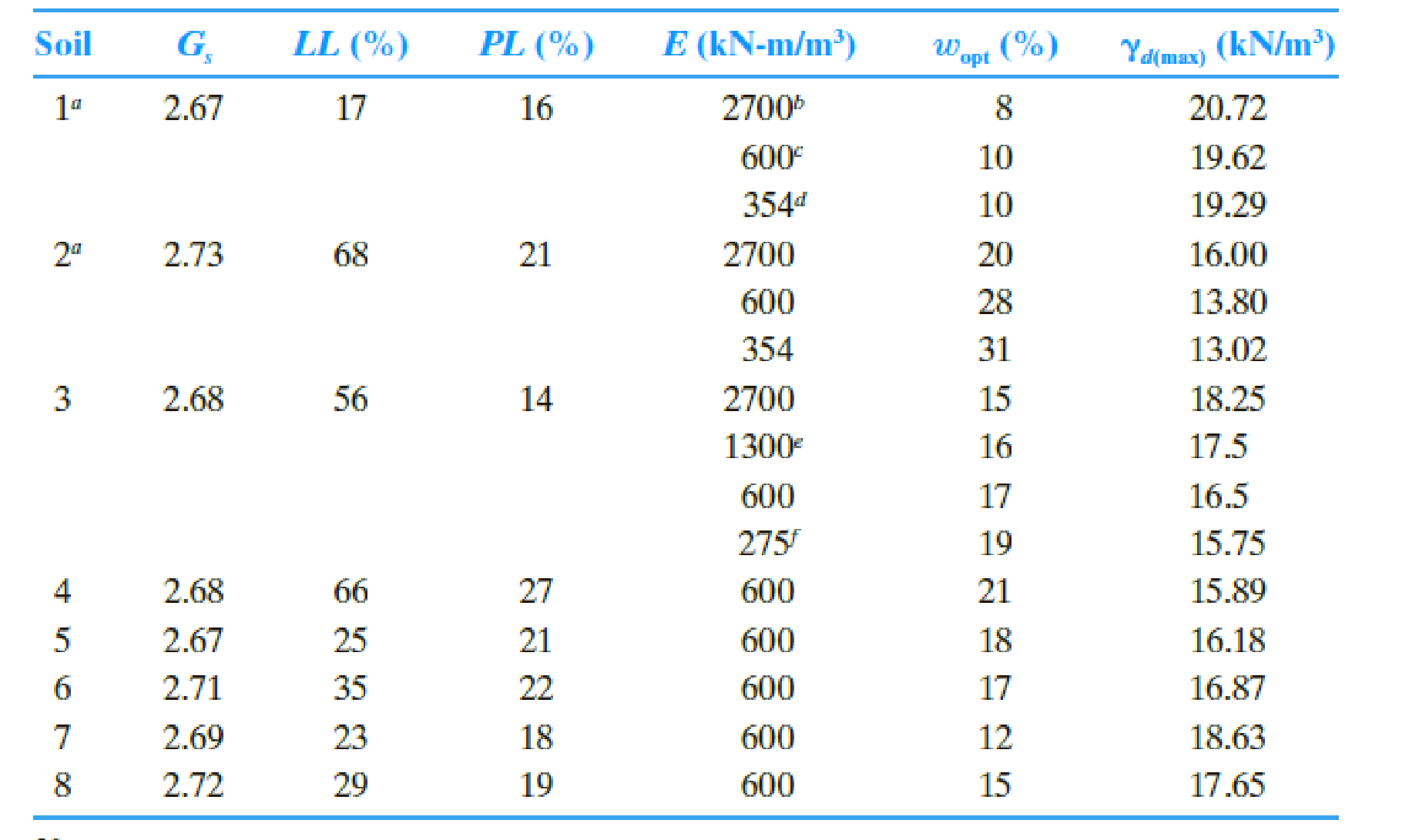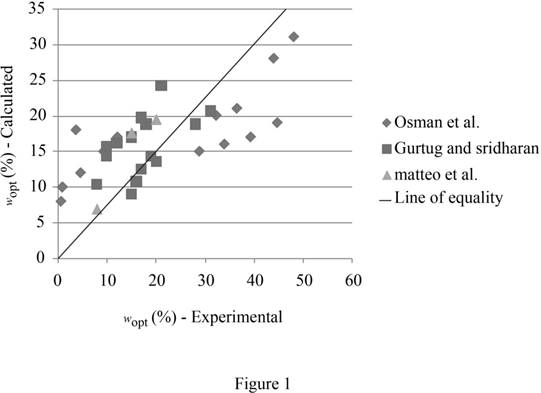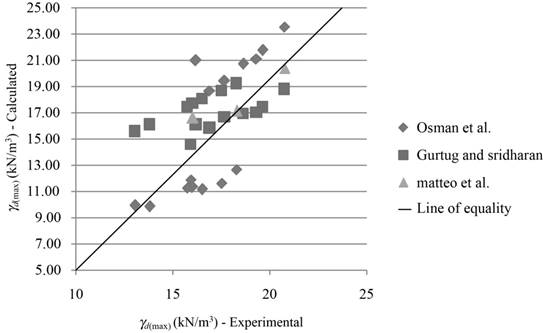
Since laboratory or field experiments are generally expensive and time consuming,
- a. Use the Osman et al. (2008) method [Eqs. (6.15) through (6.18)].
- b. Use the Gurtug and Sridharan (2004) method [Eqs. (6.13) and (6.14)].
- c. Use the Matteo et al. (2009) method [Eqs. (6.19) and (6.20)].
- d. Plot the calculated wopt against the experimental wopt, and the calculated γd(max) with the experimental γd(max). Draw a 45° line of equality on each plot.
- e. Comment on the predictive capabilities of various methods. What can you say about the inherent nature of empirical models?

(a)
Find the optimum moisture content and maximum dry unit weight using Osman et al. (2008) method.
Explanation of Solution
Calculation:
Determine the plasticity index PI using the relation.
Here, LL is the liquid limit for soil 1 and PL is the plastic limit for soil 1.
Substitute 17 % for LL and 16 % for PL.
Similarly, calculate the PI for remaining soils.
Determine the optimum moisture content for soil 1 using the relation.
Here, E is the compaction energy for soil 1.
Substitute
Similarly, calculate the optimum moisture content for remaining soils.
Determine the value of L using the relation.
Substitute
Determine the value of M using the relation.
Substitute
Determine the maximum dry unit weight of the soil 1 using the relation.
Substitute 23.78 for L, 0.387 for M, and 0.69 % for
Similarly, calculate the maximum dry unit weight for remaining soils.
Summarize the calculated values as in Table 1.
| Soil |
LL (%) |
PL (%) |
PI (%) |
E |
(Exp) |
(Exp) |
| L | M |
|
| 1 | 17 | 16 | 1 | 2,700 | 8 | 20.72 | 0.69 | 23.782 | 0.387 | 23.51 |
| 600 | 10 | 19.62 | 0.93 | 21.984 | 0.277 | 21.73 | ||||
| 354 | 10 | 19.29 | 1.02 | 21.354 | 0.238 | 21.11 | ||||
| 2 | 68 | 21 | 47 | 2,700 | 20 | 16.00 | 32.26 | 23.782 | 0.387 | 11.30 |
| 600 | 28 | 13.80 | 43.92 | 21.984 | 0.277 | 9.82 | ||||
| 354 | 31 | 13.02 | 48.01 | 21.354 | 0.238 | 9.91 | ||||
| 3 | 56 | 14 | 42 | 2,700 | 15 | 18.25 | 28.82 | 23.782 | 0.387 | 12.63 |
| 1,300 | 16 | 17.50 | 33.89 | 22.908 | 0.333 | 11.61 | ||||
| 600 | 17 | 16.50 | 39.24 | 21.984 | 0.277 | 11.12 | ||||
| 275 | 19 | 15.75 | 44.65 | 21.052 | 0.220 | 11.23 | ||||
| 4 | 66 | 27 | 39 | 600 | 21 | 15.89 | 36.45 | 21.984 | 0.277 | 11.89 |
| 5 | 25 | 21 | 4 | 600 | 18 | 16.18 | 3.740 | 21.984 | 0.277 | 20.95 |
| 6 | 35 | 22 | 13 | 600 | 17 | 16.87 | 12.15 | 21.984 | 0.277 | 18.62 |
| 7 | 23 | 18 | 5 | 600 | 12 | 18.63 | 4.67 | 21.984 | 0.277 | 20.69 |
| 8 | 29 | 19 | 10 | 600 | 15 | 17.65 | 9.35 | 21.984 | 0.277 | 19.39 |
(b)
Find the optimum moisture content and maximum dry unit weight using Gurtug and Sridharan (2004) method.
Explanation of Solution
Calculation:
Determine the optimum moisture content for soil 1 using the relation.
Substitute
Determine the maximum dry unit weight of the soil 1 using the relation.
Substitute 10.34 % for
Similarly, calculate the maximum dry unit weight for remaining soils.
Summarize the calculated values as in Table 2.
| Soil |
PL (%) |
E |
(Exp) |
(Exp) |
|
|
| 1 | 16 | 2,700 | 8 | 20.72 | 10.34 | 18.77 |
| 600 | 10 | 19.62 | 14.31 | 17.46 | ||
| 354 | 10 | 19.29 | 15.70 | 17.02 | ||
| 2 | 21 | 2,700 | 20 | 16.00 | 13.57 | 17.69 |
| 600 | 28 | 13.80 | 18.78 | 16.08 | ||
| 354 | 31 | 13.02 | 20.61 | 15.55 | ||
| 3 | 14 | 2,700 | 15 | 18.25 | 9.05 | 19.22 |
| 1,300 | 16 | 17.50 | 10.73 | 18.64 | ||
| 600 | 17 | 16.50 | 12.52 | 18.04 | ||
| 275 | 19 | 15.75 | 14.32 | 17.45 | ||
| 4 | 27 | 600 | 21 | 15.89 | 24.15 | 14.58 |
| 5 | 21 | 600 | 18 | 16.18 | 18.78 | 16.08 |
| 6 | 22 | 600 | 17 | 16.87 | 19.67 | 15.82 |
| 7 | 18 | 600 | 12 | 18.63 | 16.10 | 16.89 |
| 8 | 19 | 600 | 15 | 17.65 | 16.99 | 16.62 |
(c)
Find the optimum moisture content and maximum dry unit weight using Matteo et al. method.
Explanation of Solution
Calculation:
Determine the optimum moisture content for soil 1 using the relation.
Substitute 17 % LL and
Determine the maximum dry unit weight of the soil 1 using the relation.
Substitute 6.94 % for
Similarly, calculate the maximum dry unit weight for remaining soils.
Summarize the calculated values as in Table 3.
| Soil |
Specific gravity |
PI (%) |
(Exp) |
(Exp) |
|
|
| 1 | 2.67 | 1 | 8 | 20.72 | 6.94 | 20.37 |
| 10 | 19.62 | 6.94 | 20.37 | |||
| 10 | 19.29 | 6.94 | 20.37 | |||
| 2 | 2.73 | 47 | 20 | 16.00 | 19.44 | 16.60 |
| 28 | 13.80 | 19.44 | 16.60 | |||
| 31 | 13.02 | 19.44 | 16.60 | |||
| 3 | 2.68 | 42 | 15 | 18.25 | 17.56 | 17.11 |
| 16 | 17.50 | 17.56 | 17.11 | |||
| 17 | 16.50 | 17.56 | 17.11 | |||
| 19 | 15.75 | 17.56 | 17.11 | |||
| 4 | 2.68 | 39 | 21 | 15.89 | 20.31 | 16.25 |
| 5 | 2.67 | 4 | 18 | 16.18 | 9.16 | 19.52 |
| 6 | 2.71 | 13 | 17 | 16.87 | 11.36 | 18.97 |
| 7 | 2.69 | 5 | 12 | 18.63 | 8.41 | 20.25 |
| 8 | 2.72 | 10 | 15 | 17.65 | 9.67 | 19.82 |
(d)
Plot the graph between the calculated
Explanation of Solution
Refer Table 1, 2, and 3.
Draw the graph between the calculated

Draw the graph between calculated

(e)
Comment on the predictive capabilities of various methods and comment about the inherent nature of empirical models.
Explanation of Solution
Prediction of optimum moisture content:
Refer Figure (1), several data points are closely packed around the
Prediction of maximum dry unit weight:
Most data points for all models show good covenant between the calculated and the experimental values.
The empirical models are often limited to the materials, test methods and environmental conditions under which the experiments were conducted and the developed models. For new materials and conditions, the predicted values may not be reliable.
Want to see more full solutions like this?
Chapter 6 Solutions
Bundle: Principles Of Geotechnical Engineering, Loose-leaf Version, 9th + Mindtap Engineering, 2 Terms (12 Months) Printed Access Card
- A gravity retaining wall is shown in the figure below. Calculate the factor of safety with respect to overturning and sliding, given the following data: Wall dimensions: H = 6 m, x₁ = 0.6 m, x2 = 2 m, x3 = 2m, x4 0.5 m, x5 = 0.75 m, x6 = 0.8 m, D= 1.5 m Soil properties: 71 = 14 kN/m³, ₁ = 32°, 72 = 18 kN/m³, 2=22°, c₂ = 40 kN/m² Y₁ c₁ = 0 H Φί x5 x6 Use the Rankine active earth pressure in your calculation. Use Yconcrete = 23.08 kN/m³. Also, use k₁ = k₂ = 2/3 and Pp = 0 in the equation FS (sliding) (ΣV) tan(k102) + Bk2c2 + Pp Pa cos a (Enter your answers to three significant figures.) FS (overturning) FS (sliding) =arrow_forwardFor the cantilever retaining wall shown in the figure below, let the following data be given: Wall dimensions: H = 8 m, x1 = 0.4 m, x2 = 0.6 m, x3 = 1.5 m, x4 3.5 m, x5 = 0.96 m, D= 1.75 m, a = 10° Soil properties: 71 = 14.8 kN/m³, ₁ = 32°, Y₂ = 1 2 = 28°, c = 30 kN/m² 17.6 kN/m³, The value of Ka is 0.3210. For 2 = 28°: N = 25.80; N₁ = 14.72; N₁ = 16.72. c=0 H Χς Calculate the factor of safety with respect to overturning, sliding, and bearing capacity. Use Yconcrete = 21.58 kN/m³. Also, use k₁ = k₂ = 2/3 and P = 0 in the equation FS (sliding) (ΣV) tan(k₁₂) + Bk2C + Pp Pa cosa (Enter your answers to three significant figures.) FS (overturning) FS (sliding) FS (bearing) =arrow_forwardQuestion 2 The following strains are obtained by a 0-60-120 strain rosette: ε0 = 300 x 10-6, 60 = 200 x 10-6 and 120= 150 x 10-6. i. Determine strains Ex, Ey and Yxy ii. Determine the strains for 0 = 40° iii. Calculate principal strains, maximum shear strain and the orientation of principal strains iv. Determine normal stresses (σx, σy) and shear stress (Txy), if E = 200kPa and v = 0.25. (Hint: You may use stress-strain relationship for plane strain, summarised in matric format as follows: E σχ бу 1-v v 0 Ex = v 1-v 0 Ey txy. (1+v)(1 − 2v) 0 0 0.5 varrow_forward
- A gravity retaining wall is shown in the figure below. Calculate the factor of safety with respect to overturning and sliding, given the following data: Wall dimensions: H = 6 m, x1 = 0.6 m, x2 = 2 m, x3 = 2m, x4 0.5 m, x5 = 0.75 m, x6 = 0.8 m, D= 1.5 m Soil properties: 71 = 15.5 kN/m³, ₁ = 32°, Y2 = 18 kN/m³, 2=22°, c₂ = 40 kN/m² H x6 X2 TXT X3 Use Coulomb's active earth pressure in your calculation and let ' = 2/3 01. Use Yconcrete = 23.58 kN/m³. Also, use k₁ = k₂ = 2/3 and P = 0 in equation FS (sliding) (ΣV) tan(k₁₂2) + Bk2c + Pp Pa cos a For 1 = 32°, a = 0°, B = 71.57°, Ka = 0.45, 8' = 21.33°. (Enter your answers to three significant figures.) FS (overturning) FS (sliding) =arrow_forwardFor the cantilever retaining wall shown in the figure below, let the following data be given: Wall dimensions: H = 6.5 m, x1 = 0.3 m, x2 = 0.6 m, x3 = 0.8 m, x4 2 m, x5 = 0.8 m, D= 1.5 m, a = 0° Soil properties: 71 = 17.08 kN/m³, ₁ = 36°, Y2 = 19.65 kN/m³, 2 = 15°, c₂ = 30 kN/m² For 2=15°: N = 10.98; N₁ = 3.94; N₁ = 2.65. x2 .. c₁ = 0 Φί H x5 Calculate the factor of safety with respect to overturning, sliding, and bearing capacity. Use Yconcrete = 24.58 kN/m³. Also, use k₁ = k2 = 2/3 and P₂ = 0 in equation (EV) tan(k102) + Bk2c₂ + Pp FS (sliding) Pa cos a (Enter your answers to three significant figures.) FS (overturning) FS (sliding) FS (bearing) = = =arrow_forwardA) # of Disinfection Clearwells: 3 B) Clearwell Operation Style: Parallel (to provide contact time for disinfection using free chlorine (derived from a hypochlorite solution generated onsite). C) The facility's existing system to generate hypochlorite onsite has reached the end of its useful life, and the current operating capacity is insufficient to generate the required mass flow of hypochlorite to accommodate the future capacity of 34.5 MGD. Assume the facility plans to stop generating hypochlorite onsite and will instead purchase a bulk solution of sodium hypochlorite D) Sodium hypochlorite (NaOCI) concentration: 6.25% NaOCI by mass E) Bulk Density: 1,100 kg/m^3 F) Clearwell T10/DT Ratio: (CW1 0.43). (CW2 = 0.51), (CW3 = 0.58) DT is the theoretical mean hydraulic retention time (V/Q) G) pH: 7.0 H) Design Temperature: 15°C 1) 50% of Chlorine is lost in each clearwell J) If the concentration going into the clearwell is C, then you can assume that the concentration leaving the…arrow_forward
- Please explain step by step, and show formulaarrow_forwardNote: Please deliver a clear, step-by-step simplified handwritten solution (without any explanations) that is entirely manually produced without AI assistance. I expect an expert-level answer, and I will evaluate and rate it based on the quality and accuracy of the work, using the provided image for additional reference. Ensure every detail is thoroughly checked for correctness before submission.arrow_forwardPlease don't explain it. But draw it out for me kindly. And appreciate your time!. All the info is in the images. Thanks!.arrow_forward
- Design a simply supported one-way pavement slab for a factored applied moment, Mu = 10 ft-kip. Use f c’ = 5,000 psi and f y = 60,000 psi. The slab is in permanent contact with soil.Hint:• Estimate a minimum slab thickness for deflection control.• Solve for the slab steel based on cover for soil contactarrow_forwardThe figures below shows the framing plan and section of a reinforced concrete floor system. Floor beams are shown as dotted lines. The weight of the ceiling and floor finishing is 6 psf, that of the mechanical and electrical systems is 7 psf, and the weight of the partitions is 180 psf. The floor live load is 105 psf. The 7 in. thick slab exterior bay (S-1) is reinforced with #5 rebars @ 10 in. o.c. as the main positive reinforcement at the mid span, and #4 @ 109 in. for the shrinkage and temperature reinforcement. The panel is simply supported on the exterior edge and monolithic with the beam at the interior edge. Check the adequacy of the slab. Use the ACI moment coefficients. fc’ = 6,000 psi and fy = 60,000 psi. The slab is in an interior location. Hint: • Estimate total dead load. Find factored maximum positive bending moment in the end span. • Find design positive moment capacity. • Compare and determine adequacy, including safety and economy.arrow_forward1 For an reinforced concrete two-way slab shown in figure under the load (P). (the slab continuous over all edges - all sides are fixed), Determine (By using yield line theory): A- Draw the Yield line Pattern B- Determine the moment m C- Find The required flexural steel to resist the loads causing the slab to collapse if P = 200 KN, f=28 MPa, fy = 420 MPa d = 120 mm. Use 10 mm bars. (Prin = 0.002) +2 m 6 m -8 m 3 marrow_forward
 Principles of Geotechnical Engineering (MindTap C...Civil EngineeringISBN:9781305970939Author:Braja M. Das, Khaled SobhanPublisher:Cengage Learning
Principles of Geotechnical Engineering (MindTap C...Civil EngineeringISBN:9781305970939Author:Braja M. Das, Khaled SobhanPublisher:Cengage Learning Fundamentals of Geotechnical Engineering (MindTap...Civil EngineeringISBN:9781305635180Author:Braja M. Das, Nagaratnam SivakuganPublisher:Cengage Learning
Fundamentals of Geotechnical Engineering (MindTap...Civil EngineeringISBN:9781305635180Author:Braja M. Das, Nagaratnam SivakuganPublisher:Cengage Learning Construction Materials, Methods and Techniques (M...Civil EngineeringISBN:9781305086272Author:William P. Spence, Eva KultermannPublisher:Cengage Learning
Construction Materials, Methods and Techniques (M...Civil EngineeringISBN:9781305086272Author:William P. Spence, Eva KultermannPublisher:Cengage Learning Principles of Foundation Engineering (MindTap Cou...Civil EngineeringISBN:9781337705028Author:Braja M. Das, Nagaratnam SivakuganPublisher:Cengage Learning
Principles of Foundation Engineering (MindTap Cou...Civil EngineeringISBN:9781337705028Author:Braja M. Das, Nagaratnam SivakuganPublisher:Cengage Learning Principles of Foundation Engineering (MindTap Cou...Civil EngineeringISBN:9781305081550Author:Braja M. DasPublisher:Cengage Learning
Principles of Foundation Engineering (MindTap Cou...Civil EngineeringISBN:9781305081550Author:Braja M. DasPublisher:Cengage Learning Traffic and Highway EngineeringCivil EngineeringISBN:9781305156241Author:Garber, Nicholas J.Publisher:Cengage Learning
Traffic and Highway EngineeringCivil EngineeringISBN:9781305156241Author:Garber, Nicholas J.Publisher:Cengage Learning





